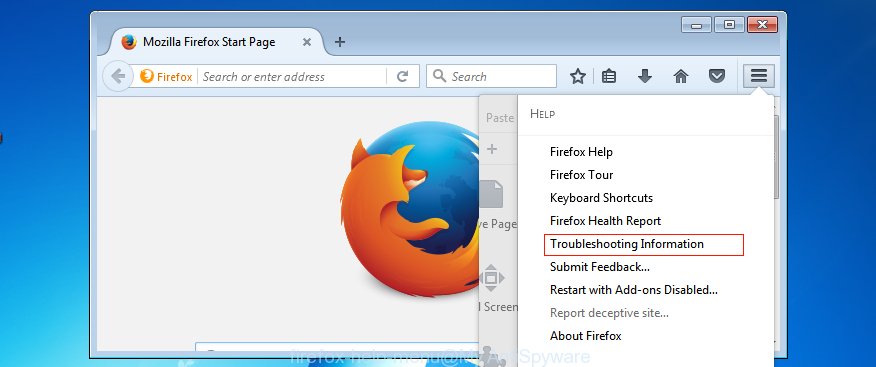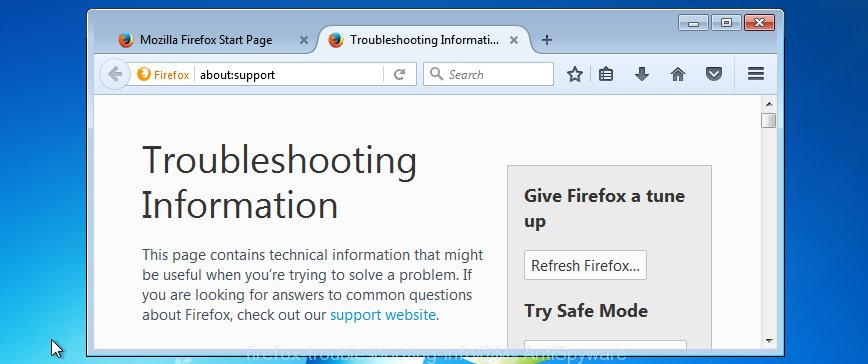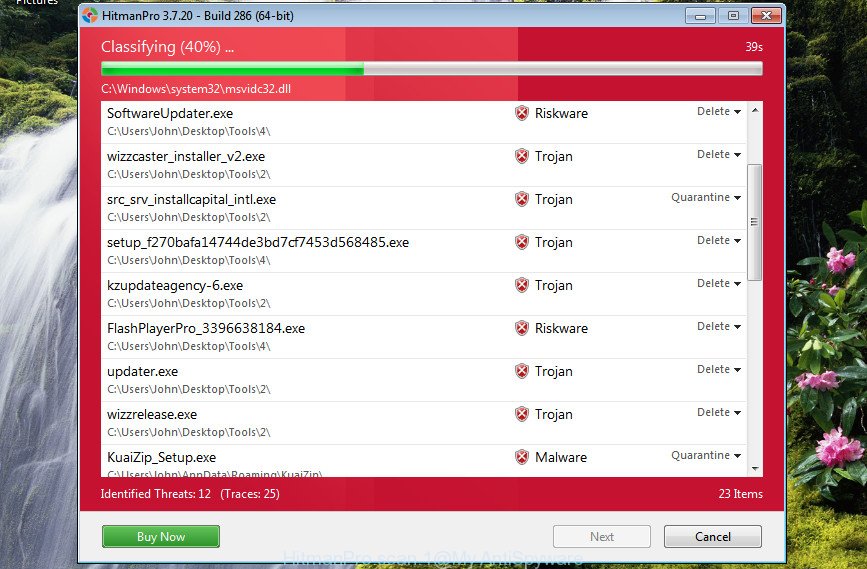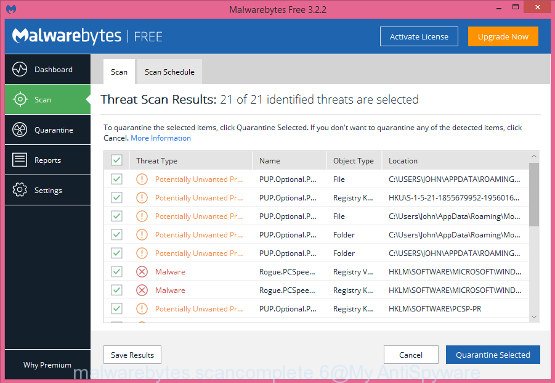Are you facing a problem with the MS Edge, Mozilla Firefox, IE and Chrome web browsers that constantly display unwanted “Windows Security Center: Your McAfee subscription has expired today.” pop-ups? Then, there are chances that are your PC system is affected by ‘ad-supported’ software (also known as adware).

“Windows Security Center popup scam” is a misleading advertising
In most cases, the adware installs on the computer in a bundle with free software that you downloaded and installed from the Net. Once it gets inside your computer, it will change certain computer’s settings including homepage, search provider and new tab page in order to redirect your’s browser to unwanted web-pages or display a huge count of intrusive pop up advertisements from various third-party ad networks.
The ad-supported software that shows misleading Windows Security Center pop-up warnings on your computer, is not a virus, but the virus behaves similarly. It changes internet browser settings and blocks them from changing. Also the adware can install additional web browser extensions and modules that will inject sponsored links within the Google Chrome, Firefox, Edge and Internet Explorer’s screen. Moreover, the ad supported software may install a web browser extension that once started, will alter the web browser’s start page and search provider.
That is, it is obvious that adware can steal personal information such as: your ip address, what is a web-page you are viewing now, what you are looking for on the Internet, which links you are clicking, and much, much more. Even worse, the adware may monetize its functionality by gathering privacy info from your surfing sessions. This confidential info, afterwards, can be easily used for marketing purposes. This puts your user data at a security risk.
Thus, it is clear that the presence of adware on your PC is not desirable, and you need to clean up your computer immediately. Follow the step-by-step guidance below in order to remove Windows Security Center popup.
How to remove Windows Security Center popup scam
We can help you delete Windows Security Center from your browsers, without the need to take your machine to a professional. Simply follow the removal instructions below if you currently have the annoying ad-supported software on your computer and want to remove it. If you have any difficulty while trying to remove the ad supported software that cause misleading Windows Security Center pop-up scam to appear, feel free to ask for our help in the comment section below. Certain of the steps will require you to restart your personal computer or exit this web site. So, read this tutorial carefully, then bookmark or print it for later reference.
To remove Windows Security Center, follow the steps below:
- How to get rid of Windows Security Center pop-up without any software
- Scan your PC system and remove Windows Security Center fake alerts with free tools
- How to block Windows Security Center pop-up warnings
- Where the Windows Security Center fake alerts comes from
- Finish words
How to get rid of Windows Security Center pop-up without any software
The following instructions is a step-by-step guide, which will help you manually get rid of Windows Security Center fake alerts from the Internet Explorer, Mozilla Firefox, Chrome and MS Edge.
Remove suspicious software using MS Windows Control Panel
It’s of primary importance to first identify and remove all potentially unwanted applications, ad-supported software software and browser hijackers through ‘Add/Remove Programs’ (Windows XP) or ‘Uninstall a program’ (Windows 10, 8, 7) section of your Microsoft Windows Control Panel.
- If you are using Windows 8, 8.1 or 10 then click Windows button, next click Search. Type “Control panel”and press Enter.
- If you are using Windows XP, Vista, 7, then press “Start” button and click “Control Panel”.
- It will open the Windows Control Panel.
- Further, press “Uninstall a program” under Programs category.
- It will display a list of all applications installed on the system.
- Scroll through the all list, and delete questionable and unknown programs. To quickly find the latest installed programs, we recommend sort applications by date.
See more details in the video instructions below.
Remove Windows Security Center popup warnings from Chrome
Reset Chrome settings to remove Windows Security Center fake alerts. If you are still experiencing issues with Windows Security Center popup warnings, you need to reset Chrome browser to its original settings. This step needs to be performed only if adware has not been removed by the previous steps.
First start the Google Chrome. Next, click the button in the form of three horizontal dots (![]() ).
).
It will open the Google Chrome menu. Select More Tools, then click Extensions. Carefully browse through the list of installed plugins. If the list has the extension signed with “Installed by enterprise policy” or “Installed by your administrator”, then complete the following tutorial: Remove Google Chrome extensions installed by enterprise policy.
Open the Chrome menu once again. Further, click the option called “Settings”.

The browser will show the settings screen. Another way to display the Google Chrome’s settings – type chrome://settings in the web browser adress bar and press Enter
Scroll down to the bottom of the page and click the “Advanced” link. Now scroll down until the “Reset” section is visible, as shown on the image below and press the “Reset settings to their original defaults” button.

The Google Chrome will open the confirmation prompt as shown on the screen below.

You need to confirm your action, click the “Reset” button. The internet browser will launch the task of cleaning. When it’s finished, the web browser’s settings including start page, search engine and new tab back to the values that have been when the Google Chrome was first installed on your PC.
Remove Windows Security Center pop-up warnings from Internet Explorer
By resetting Internet Explorer web-browser you return your internet browser settings to its default state. This is good initial when troubleshooting problems that might have been caused by adware that causes misleading Windows Security Center popup on your web-browser.
First, open the IE, click ![]() ) button. Next, press “Internet Options” as displayed in the following example.
) button. Next, press “Internet Options” as displayed in the following example.

In the “Internet Options” screen select the Advanced tab. Next, click Reset button. The Internet Explorer will display the Reset Internet Explorer settings dialog box. Select the “Delete personal settings” check box and press Reset button.

You will now need to restart your system for the changes to take effect. It will get rid of adware that made to show misleading Windows Security Center pop up within your web-browser, disable malicious and ad-supported web browser’s extensions and restore the Internet Explorer’s settings such as default search engine, homepage and new tab to default state.
Delete Windows Security Center pop-up warnings from Firefox
This step will help you delete Windows Security Center pop up warnings, third-party toolbars, disable harmful addons and restore your default start page, newtab and search engine settings.
Start the Mozilla Firefox and click the menu button (it looks like three stacked lines) at the top right of the web-browser screen. Next, press the question-mark icon at the bottom of the drop-down menu. It will show the slide-out menu.

Select the “Troubleshooting information”. If you are unable to access the Help menu, then type “about:support” in your address bar and press Enter. It bring up the “Troubleshooting Information” page as shown in the following example.

Click the “Refresh Firefox” button at the top right of the Troubleshooting Information page. Select “Refresh Firefox” in the confirmation prompt. The Mozilla Firefox will begin a task to fix your problems that caused by the Windows Security Center ad supported software. After, it’s done, click the “Finish” button.
Scan your PC system and remove Windows Security Center fake alerts with free tools
Manual removal is not always as effective as you might think. Often, even the most experienced users may not completely get rid of ad-supported software which shows misleading Windows Security Center pop-up on your machine. So, we recommend to check your PC for any remaining harmful components with free ad supported software removal programs below.
How to delete Windows Security Center pop-up warnings with Zemana Anti Malware
We recommend using the Zemana AntiMalware. You can download and install Zemana to look for and remove Windows Security Center pop-up from the Microsoft Edge, Internet Explorer, Mozilla Firefox and Google Chrome web browsers. When installed and updated, the malicious software remover will automatically scan and detect all threats exist on your computer.
Download Zemana Free on your system by clicking on the link below.
164298 downloads
Author: Zemana Ltd
Category: Security tools
Update: July 16, 2019
Once the downloading process is done, start it and follow the prompts. Once installed, the Zemana Free will try to update itself and when this process is finished, click the “Scan” button for scanning your personal computer for the adware which cause misleading Windows Security Center pop-up warnings to appear.

This process can take quite a while, so please be patient. When a threat is detected, the number of the security threats will change accordingly. When you’re ready, click “Next” button.

The Zemana Anti-Malware (ZAM) will delete adware that causes misleading Windows Security Center pop up scam on your internet browser.
Scan your PC system and delete Windows Security Center pop up scam with Hitman Pro
HitmanPro is a free removal utility that may be downloaded and use to delete ad supported software that causes web browsers to display misleading Windows Security Center fake alerts, hijackers, malicious software, potentially unwanted software, toolbars and other threats from your computer. You can run this utility to find threats even if you have an antivirus or any other security application.

- Installing the Hitman Pro is simple. First you’ll need to download Hitman Pro by clicking on the link below. Save it to your Desktop so that you can access the file easily.
- Once downloading is complete, start the HitmanPro, double-click the HitmanPro.exe file.
- If the “User Account Control” prompts, click Yes to continue.
- In the HitmanPro window, press the “Next” . Hitman Pro program will scan through the whole personal computer for the ad supported software which displays misleading Windows Security Center popup scam on your personal computer. This task may take some time, so please be patient. While the tool is scanning, you can see how many objects and files has already scanned.
- Once the system scan is complete, Hitman Pro will open a screen which contains a list of malware that has been detected. All detected items will be marked. You can get rid of them all by simply press “Next”. Now, click the “Activate free license” button to begin the free 30 days trial to remove all malicious software found.
Automatically get rid of Windows Security Center popup scam with MalwareBytes
Manual Windows Security Center pop-up removal requires some computer skills. Some files and registry entries that created by the ad supported software can be not completely removed. We recommend that run the MalwareBytes Anti-Malware (MBAM) that are fully clean your system of adware. Moreover, the free program will help you to remove malicious software, potentially unwanted programs, browser hijackers and toolbars that your PC may be infected too.

Visit the page linked below to download the latest version of MalwareBytes Free for Microsoft Windows. Save it on your Desktop.
326638 downloads
Author: Malwarebytes
Category: Security tools
Update: April 15, 2020
Once the download is finished, run it and follow the prompts. Once installed, the MalwareBytes will try to update itself and when this process is finished, press the “Scan Now” button . MalwareBytes utility will begin scanning the whole system to find out ad supported software that causes misleading Windows Security Center fake alerts on your browser. A scan can take anywhere from 10 to 30 minutes, depending on the count of files on your PC system and the speed of your system. When a threat is found, the number of the security threats will change accordingly. Wait until the the checking is complete. Review the results once the tool has finished the system scan. If you think an entry should not be quarantined, then uncheck it. Otherwise, simply click “Quarantine Selected” button.
The MalwareBytes Free is a free application that you can use to get rid of all detected folders, files, services, registry entries and so on. To learn more about this malware removal tool, we recommend you to read and follow the few simple steps or the video guide below.
How to block Windows Security Center pop-up warnings
If you surf the Web, you can’t avoid malvertising. But you can protect your web-browser against it. Download and use an ad-blocker program. AdGuard is an ad-blocker which can filter out tons of of the malicious advertising, blocking dynamic scripts from loading harmful content.
Please go to the following link to download AdGuard. Save it on your Windows desktop or in any other place.
26725 downloads
Version: 6.4
Author: © Adguard
Category: Security tools
Update: November 15, 2018
When the downloading process is done, launch the downloaded file. You will see the “Setup Wizard” screen as displayed on the image below.

Follow the prompts. Once the installation is complete, you will see a window as shown on the screen below.

You can click “Skip” to close the installation program and use the default settings, or press “Get Started” button to see an quick tutorial that will help you get to know AdGuard better.
In most cases, the default settings are enough and you do not need to change anything. Each time, when you start your computer, AdGuard will start automatically and block popup advertisements, Windows Security Center redirect, as well as other malicious or misleading websites. For an overview of all the features of the program, or to change its settings you can simply double-click on the AdGuard icon, that can be found on your desktop.
Where the Windows Security Center fake alerts comes from
Most of undesired pop-up ads such as Windows Security Center ads come from browser toolbars, internet browser extensions, BHOs (browser helper objects) and additional software. In most cases, these items claim itself as programs that improve your experience on the Internet by providing a fast and interactive home page or a search engine that does not track you. Remember, how to avoid the unwanted programs. Be cautious, start only reputable software which download from reputable sources. NEVER install any unknown and suspicious applications.
Finish words
Now your PC system should be free of the adware that causes misleading Windows Security Center fake alerts on your web browser. We suggest that you keep AdGuard (to help you block unwanted pop ups and undesired harmful web-sites) and Zemana (to periodically scan your personal computer for new malware, browser hijacker infections and ad-supported software). Make sure that you have all the Critical Updates recommended for Windows OS. Without regular updates you WILL NOT be protected when new hijackers, harmful programs and adware are released.
If you are still having problems while trying to remove Windows Security Center pop-up from your browser, then ask for help here.




















